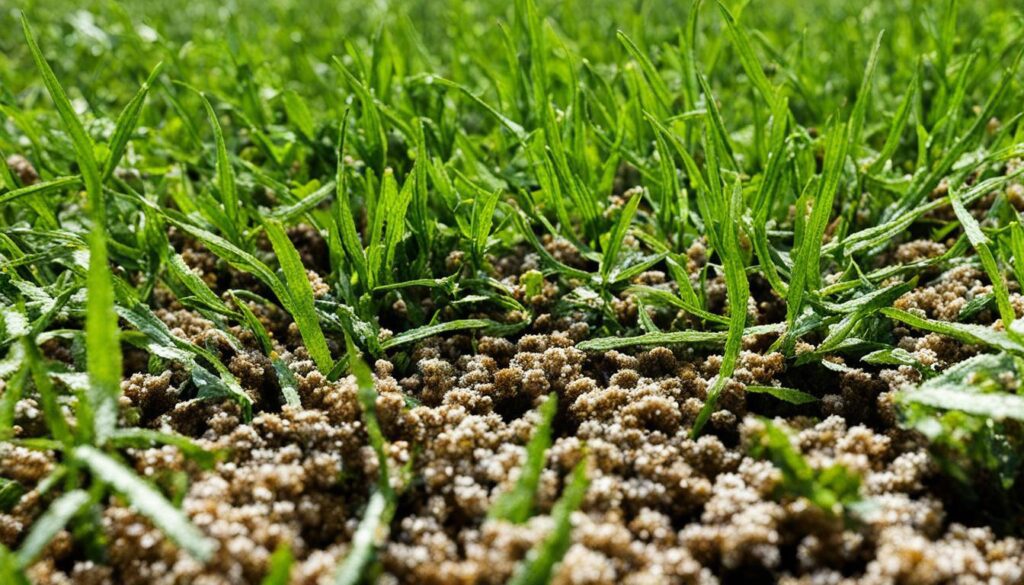Are you tired of battling stubborn weeds in your lawn? Achieving a lush, weed-free lawn requires effective weed control strategies. One powerful tool in your arsenal is the pre-emergent herbicide. By understanding how pre-emergent herbicides work and when to apply them, you can maintain a beautiful and weed-free lawn throughout the season.
Pre-emergent herbicides create a protective barrier on your lawn, preventing weeds from germinating and emerging. This makes them an essential component of any weed control plan. By utilizing pre-emergent herbicides, you can stop weeds before they even have a chance to take root, resulting in a healthier and more visually appealing lawn.
Whether you’re a seasoned gardener or just starting, this guide will provide you with all the information you need to effectively use pre-emergent herbicides for weed control. Let’s dive in and discover the key aspects of pre-emergent herbicide applications, ensuring your lawn stays lush and weed-free.
Understanding Pre-Emergent Herbicides
Pre-emergent herbicides are an essential part of weed prevention in your lawn. To effectively combat weeds, it’s crucial to understand how these herbicides work and why they are vital for maintaining a healthy, weed-free lawn.
Pre-emergent herbicides are classified based on their method of action. This refers to how they interfere with weed development, targeting the root cause of weed growth. These herbicides work by inhibiting cell division in emerging weeds and preventing certain nutrients from reaching them.
Unlike other weed control methods, pre-emergent herbicides do not prevent seed germination. Instead, they control the germination process, ensuring that weed seeds cannot sprout and establish in your lawn. By targeting weed seeds before they have a chance to grow, pre-emergent herbicides provide effective long-term weed prevention.
To maximize the effectiveness of pre-emergent herbicides, it’s important to understand their role in your overall lawn care routine. By incorporating these herbicides into your regular lawn maintenance, you can proactively control weed growth and achieve a healthier, more vibrant lawn.
Understanding how pre-emergent herbicides work is crucial for successful weed prevention in your lawn. By inhibiting cell division and controlling seed germination, these herbicides target weeds at their earliest stages of development. Incorporating pre-emergent herbicides into your lawn care routine will help you achieve a lush, weed-free lawn that you can be proud of.
When to Apply Pre-Emergent Herbicides
The timing of pre-emergent herbicide application plays a crucial role in effectively preventing weeds in your lawn. By understanding the optimal timing for application, you can significantly reduce the number of weeds and maintain a healthy, weed-free lawn.
Spring and Fall Application:
The best times to apply pre-emergent herbicides are in early spring and fall when most weeds are actively germinating. These critical seasons provide the ideal conditions for pre-emergent herbicides to work effectively, targeting specific types of weeds.
Spring applications: Spring application of pre-emergent herbicides focus on controlling summer annual weeds. These weeds, such as crabgrass, goosegrass, and foxtail, tend to sprout during warmer months and can quickly invade your lawn if left uncontrolled. By applying pre-emergent herbicides in early spring, you can prevent these weeds from taking root.
Fall applications: Fall is the perfect time to apply pre-emergent herbicides to prevent winter annual weeds. Weeds like annual bluegrass, chickweed, and henbit thrive in cooler weather and can quickly overtake your lawn if not addressed. Applying pre-emergent herbicides in the fall helps suppress the growth of these winter weeds, ensuring a weed-free lawn during the colder months.
By aligning the timing of your pre-emergent herbicide applications with the appropriate seasons, you can effectively prevent weeds from germinating and establish a healthy, vibrant lawn all year round.
How to Apply Pre-Emergent Herbicides
When it comes to applying pre-emergent herbicides, there are two primary methods you can use: granular and liquid. Each method has its own advantages and considerations, so it’s important to choose the right application method based on the type of pre-emergent herbicide you are using and the specific needs of your lawn.
Granular Herbicides
Granular herbicides are designed to be applied using a spreader. This method involves distributing the herbicide evenly across your lawn in granular form. The granules are typically larger and easier to handle, making them ideal for larger areas.
Here’s a step-by-step guide to applying granular herbicides:
- Choose a high-quality granular herbicide specifically labeled for pre-emergent weed control.
- Read and follow the manufacturer’s instructions on the packaging.
- Calibrate your spreader according to the instructions provided by the manufacturer.
- Fill the spreader with the recommended amount of granular herbicide.
- Start walking at a steady pace and activate the spreader to distribute the granules evenly across your lawn.
- Overlap each pass slightly to ensure complete coverage.
- After applying the herbicide, water the treated area lightly to activate the granules.
Liquid Herbicides
Liquid herbicides, on the other hand, are applied using a sprayer. This method allows for more precise control and targeted application, making it suitable for smaller areas or spot treatments.
Here’s how to apply liquid herbicides effectively:
- Select a high-quality liquid herbicide formulated for pre-emergent weed control.
- Follow the manufacturer’s instructions on the label carefully.
- Fill the sprayer with the recommended amount of liquid herbicide.
- Adjust the nozzle of the sprayer to achieve a fine mist or spray pattern.
- Hold the sprayer nozzle close to the ground and apply the herbicide evenly, covering the targeted area.
- Ensure thorough coverage by moving the sprayer in a slow and controlled manner.
- Take care to avoid overlapping or overspraying onto non-target plants.
Regardless of the application method you choose, it’s important to consider the weather and environmental conditions when applying pre-emergent herbicides. Avoid applying herbicides on windy days to prevent drift and always follow the manufacturer’s guidelines for specific application rates and timing.
Common Mistakes in Pre-Emergent Herbicide Application
When it comes to applying pre-emergent herbicides, there are some common mistakes that you should avoid to ensure the best results for your lawn. By understanding and avoiding these mistakes, you can effectively control weeds and maintain a healthy, lush lawn.
1. Uneven Application
One of the most common mistakes is applying the pre-emergent herbicide unevenly across your lawn. Uneven application can result in patchy weed control, with some areas being more susceptible to weed growth than others. To avoid this, make sure to follow the instructions on the herbicide label and use a spreader or sprayer to apply the herbicide evenly.
2. Incorrect Dosage
Using the incorrect dosage of pre-emergent herbicide can be ineffective in controlling weeds or even damage your lawn. Too little herbicide may not provide sufficient weed prevention, while too much can harm your grass. Always carefully follow the recommended dosage instructions provided by the manufacturer to ensure the optimal results.
3. Combining with Other Lawn Care Tasks
While multitasking can be efficient, combining pre-emergent herbicide application with other lawn care tasks like aeration or overseeding can have negative effects. This can lead to the herbicide being distributed improperly or diluted, reducing its effectiveness. It’s best to separate these tasks and give the herbicide time to work before undertaking other lawn care activities.
By avoiding these common mistakes – uneven application, incorrect dosage, and combining with other lawn care tasks – you can maximize the effectiveness of your pre-emergent herbicide application. Take the time to apply the herbicide properly and follow the recommended instructions for a weed-free and healthy lawn.
Safety and Considerations for Pre-Emergent Herbicide Use
When it comes to using pre-emergent herbicides on your turfgrass, safety is a top priority. While these herbicides are generally safe to use, there are a few considerations you should keep in mind to ensure the well-being of your lawn and pets.
Follow Label Instructions
To maintain turfgrass safety and maximize the effectiveness of the herbicide, it’s crucial to carefully read and follow the instructions provided on the label. Each herbicide may have specific guidelines regarding application rates, timing, and precautions.
Avoid Applying on Wet Lawns
It’s important to avoid applying pre-emergent herbicides on wet lawns. This is because the water can dilute the herbicide, reducing its effectiveness and potentially causing uneven application. Wait for the lawn to dry before applying the herbicide for better results.
Wait Before Introducing New Sod or Overseeding
If you’re planning to introduce new sod or overseed your lawn, it’s essential to wait after using the pre-emergent herbicide. The herbicide may hinder the germination and establishment of new grass. Follow the label instructions to determine the appropriate waiting period before proceeding with these tasks.
Pet Safety Precautions
Pet owners should be cautious when using synthetic pre-emergent herbicides. Although these herbicides are generally safe when used properly, it’s advisable to avoid allowing pets on treated areas until the herbicide has been absorbed into the ground. This can help prevent accidental ingestion or paw contact with the treated surface.
By following these application precautions and considering turfgrass and pet safety, you can achieve effective weed control and maintain a healthy, beautiful lawn.
Conclusion
Pre-emergent herbicides are an essential part of your weed prevention strategy for achieving a lush, weed-free lawn. By understanding how these herbicides work and implementing proper application techniques, you can maintain a beautiful yard throughout the season.
Timing is crucial when using pre-emergent herbicides. Applying them in early spring and fall when weeds are actively germinating can significantly reduce weed growth. Remember to choose the right product for the specific weeds you are targeting.
While applying pre-emergent herbicides, it is important to avoid common mistakes such as uneven application or incorrect dosage. Following the recommended instructions and considering weather conditions can maximize the effectiveness of the herbicide.
Lastly, ensure safety precautions are taken to protect your turfgrass and pets. Adhere to label instructions, avoid applying herbicides on wet lawns, and wait before introducing new sod or overseeding. With the right approach, pre-emergent herbicides can be a powerful tool in maintaining the lush, weed-free lawn you desire.
Can I Use Post-Emergent Herbicide After Using Pre-Emergent Herbicide for Weed Control?
Yes, you can use the best post emergent herbicide solutions after using pre-emergent herbicide for weed control. Pre-emergent herbicides prevent weed seeds from germinating, while post-emergent herbicides target existing weeds. Using both types of herbicides in conjunction can provide comprehensive weed control in your lawn or garden.
FAQ
How do pre-emergent herbicides work?
Pre-emergent herbicides work by interfering with seed germination and emergence, forming a protective barrier on your lawn during critical seasons when weeds are most active. They inhibit cell division and prevent certain nutrients from reaching the weeds, controlling their development and preventing them from sprouting.
When is the best time to apply pre-emergent herbicides?
The best times to apply pre-emergent herbicides are early spring and fall when most weeds are actively germinating. Spring applications target summer annual weeds, while fall applications target winter annual weeds. Applying these herbicides at the right time can significantly reduce the number of weeds in your lawn.
What are the different methods of applying pre-emergent herbicides?
There are two primary methods for applying pre-emergent herbicides: granular and liquid. Granular herbicides are typically applied using a spreader, while liquid herbicides are applied using a sprayer. It’s important to choose the appropriate application method based on the type of pre-emergent herbicide you are using.
What are common mistakes to avoid when applying pre-emergent herbicides?
Common mistakes to avoid include uneven application, applying too little or too much herbicide, and combining pre-emergent application with other lawn care tasks like aeration or overseeding. Understanding and avoiding these mistakes will ensure the best results from your pre-emergent herbicide application.
Are pre-emergent herbicides safe to use on turfgrass?
Pre-emergent herbicides are generally safe to use on turfgrass. However, it’s important to follow label instructions, avoid applying the herbicide on wet lawns, and wait before introducing new sod or overseeding after herbicide use. Pet owners should also be cautious with synthetic pre-emergent herbicides and avoid allowing pets on treated areas until the herbicide has been absorbed into the ground.
How effective are pre-emergent herbicides in weed prevention?
With the right understanding of how they work, when to apply them, and proper application techniques, pre-emergent herbicides can be an effective tool for weed prevention in your lawn. They can help you maintain a lush, weed-free lawn all season long.











